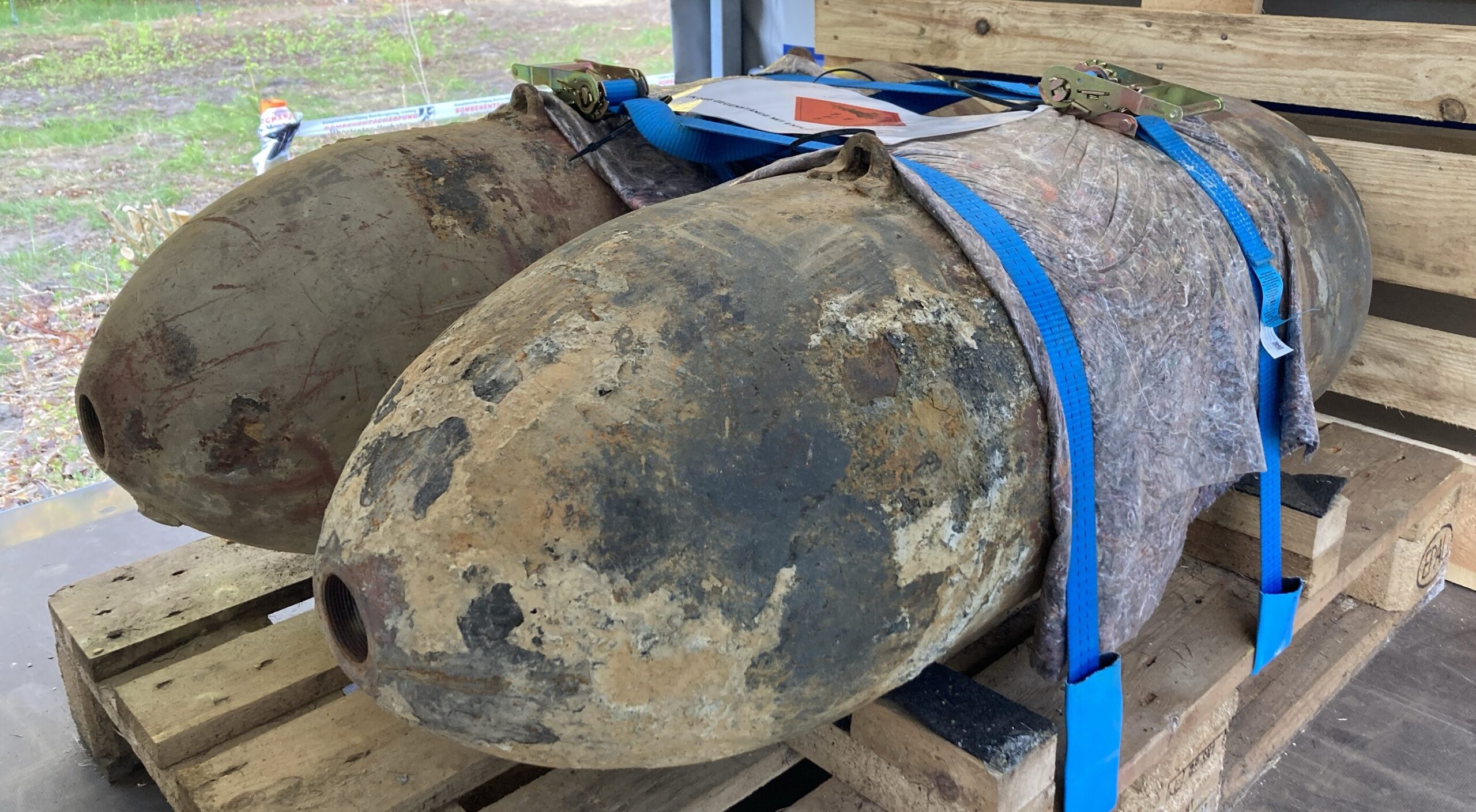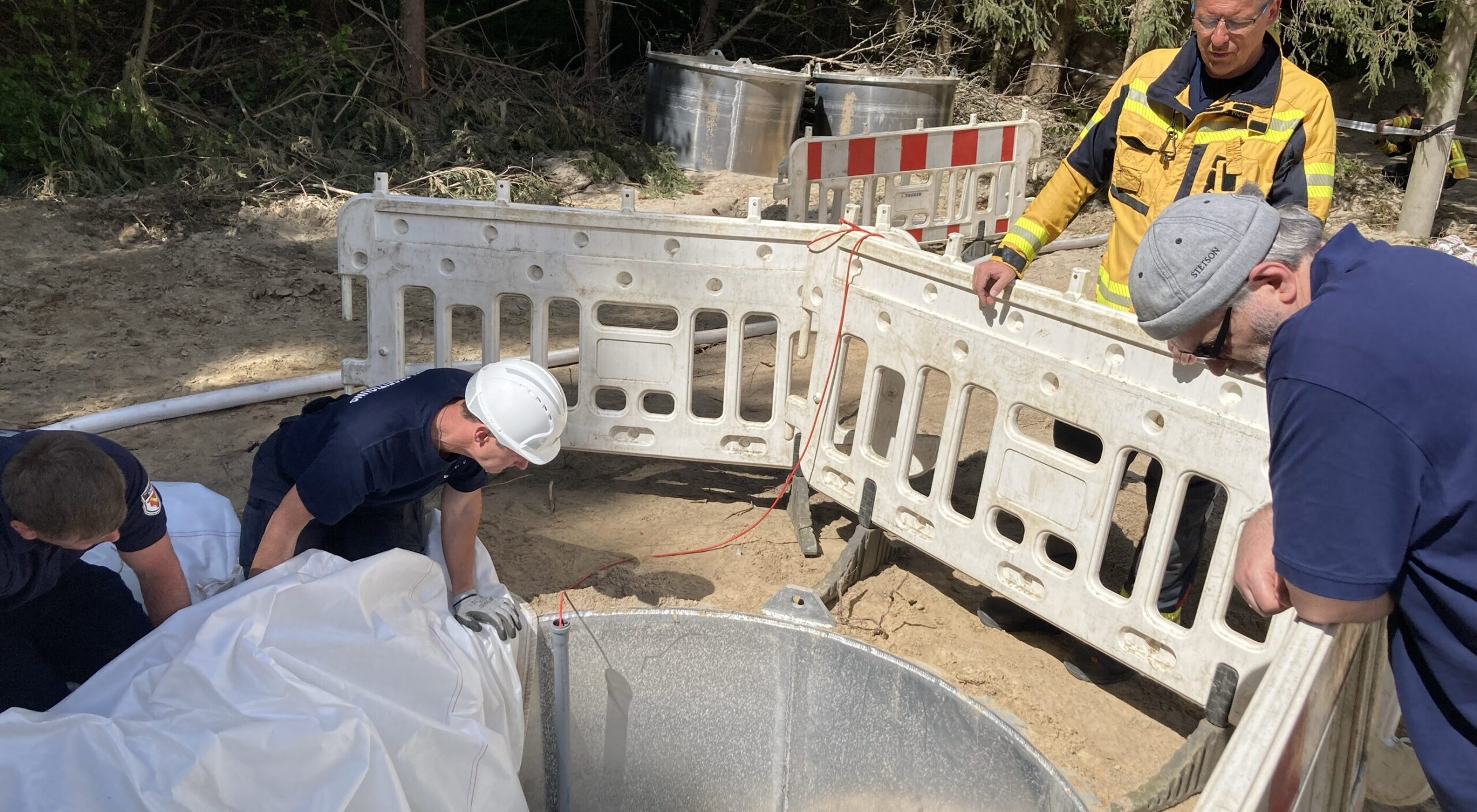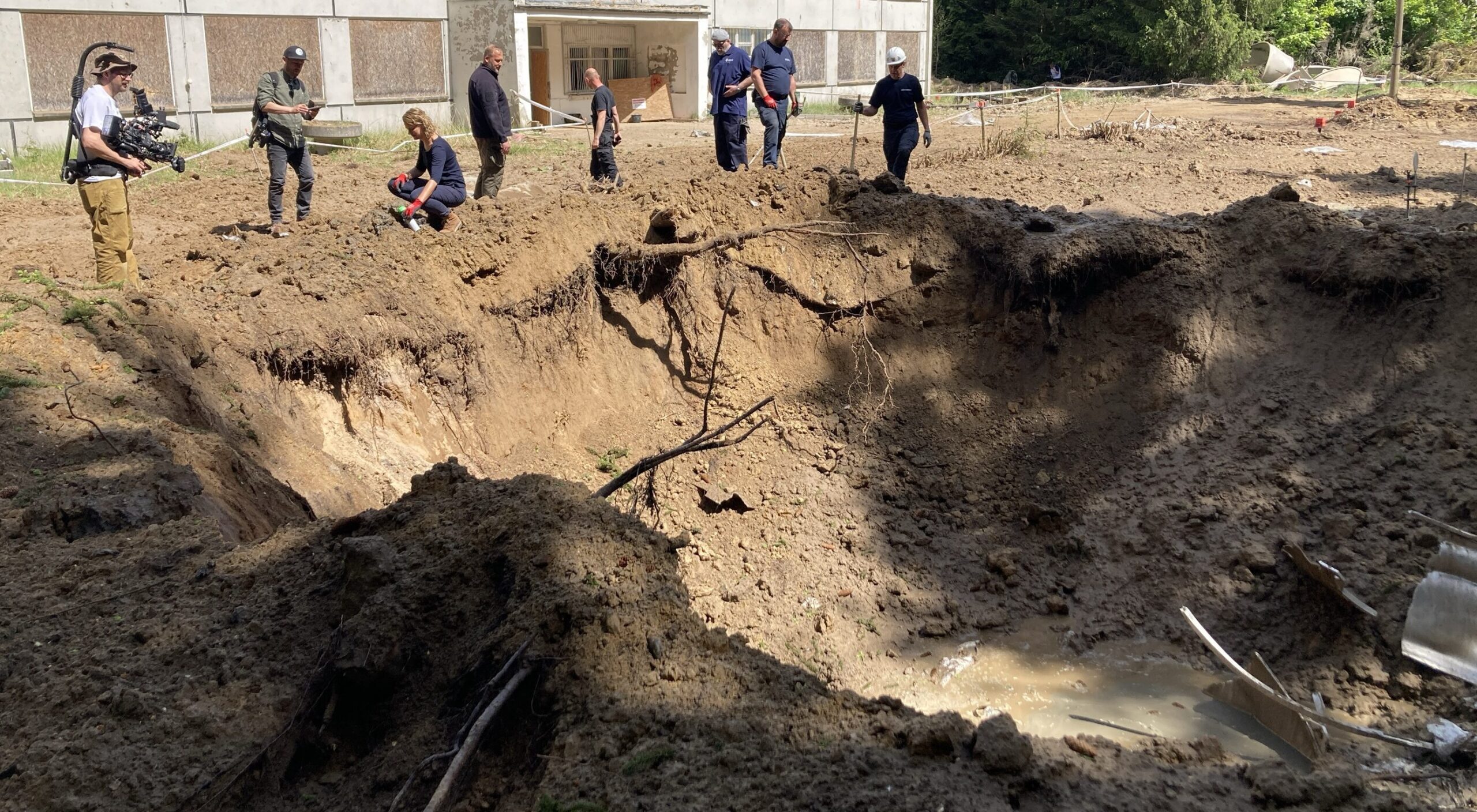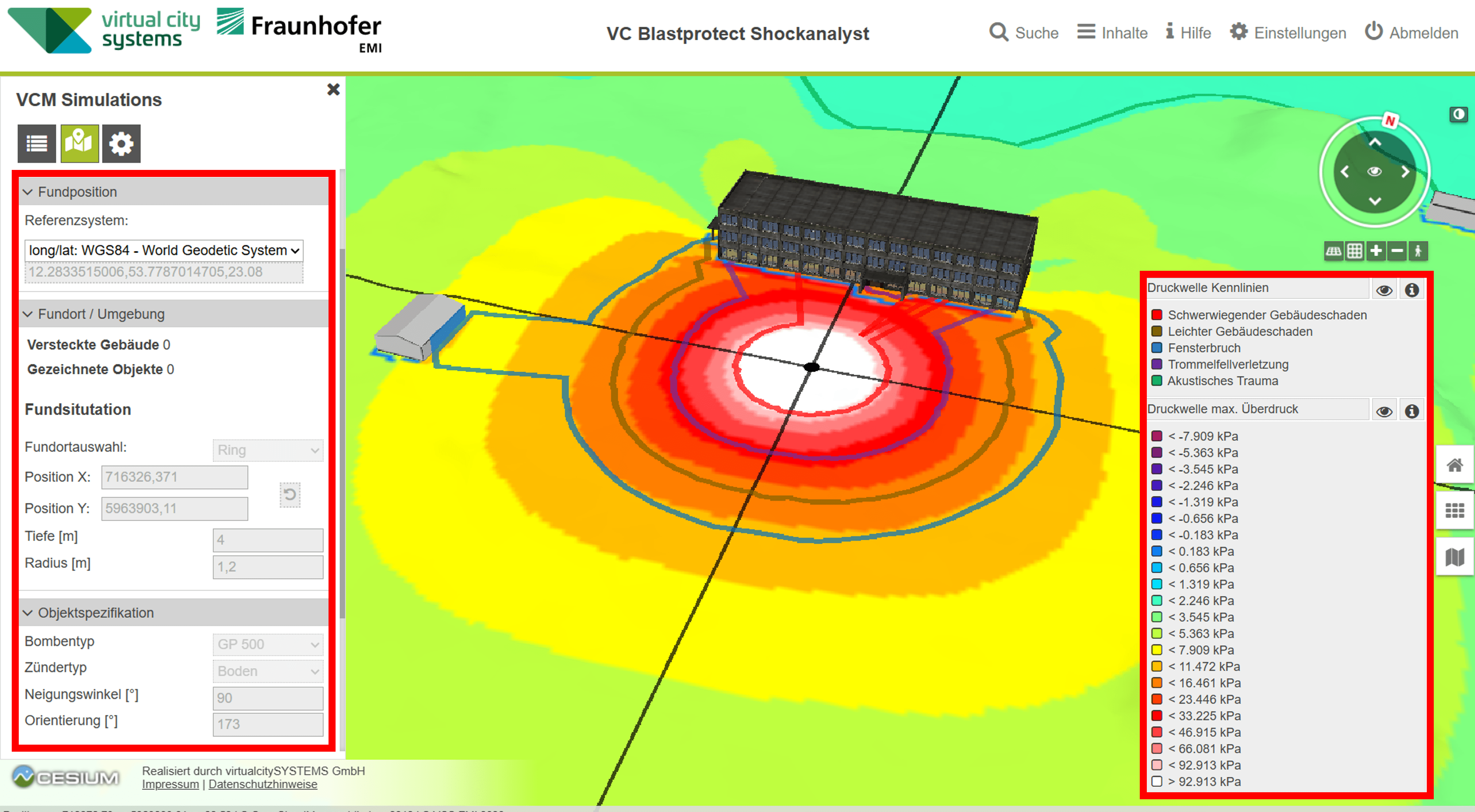Digital TwinVC Blastprotect
Largest test series since World War II: Live detonations of aerial bombs
What happens when a World War II bomb explodes – not just on the surface, but deep underground? How far does the destruction reach? And how can evacuations be planned with precision and kept as minimal as possible to ensure the best possible protection for people? These are the questions addressed by the SchockAnalyst project in a test campaign that is unprecedented to date.
From May 12 to 16, 2025, large-scale live detonations took place on the grounds of a former munitions depot owned by the Institute for Federal Real Estate near Güstrow in Mecklenburg-Vorpommern – conducted under scientific supervision and using state-of-the-art measurement technology.
Even 80 years after the end of the war, hundreds of thousands of unexploded ordnance still lie buried beneath the ground in Germany—often right in the middle of densely populated cities. The danger becomes clear with every new discovery: people must be evacuated, entire streets closed off, and rail traffic suspended. The situation becomes especially critical when hospitals or other vital infrastructure are nearby. But how accurately can we assess which areas are truly at risk?
Up to now, most models have focused on the effects of blast waves and flying shrapnel. However, there has been little data on how to evaluate the effectiveness of damping measures or how the energy spreads underground—impacting pipelines, subterranean infrastructure, and the foundations of nearby buildings.
As part of the project funded by the German Federal Ministry of Education and Research (BMBF), six controlled detonations were carried out using 500-pound bombs—the very type most commonly found in Germany.
The explosions were conducted under realistic conditions, including various damping measures such as sand and water, combined with precise sensors to measure pressure waves, shrapnel distribution, and especially ground shockwaves.
The goal was to collect reliable data that can serve as a foundation for improving and further developing simulation models.
At the heart of the tests is the further development of the simulation solution VC Blastprotect, developed by Virtual City Systems in close collaboration with the Fraunhofer Ernst-Mach-Institute (EMI) and the Explosive Ordnance Disposal Service of North Rhine-Westphalia (Kampfmittelräumdienst NRW).
The project addresses three key challenges:
- Validation of existing models
The measurement data from the detonation tests were used to verify and validate the calculations implemented in VC Blastprotect for blast waves and fragment trajectories under real-world conditions. - Module expansion for ground shockwaves
Based on the newly collected data, a new simulation module is being developed that will make it possible to assess the underground impacts of explosions—such as on basements, building foundations, or utility lines. - Integration of damping measures
Another objective is to enable VC Blastprotect to account for mitigating measures—such as the use of sand or water—in risk assessments. This will allow targeted planning of damage-reduction strategies directly on-site.
VC Blastprotect is already in practical use by bomb disposal services and other experts as a decision-support system. It provides a solid foundation—based on physical models—for developing realistic evacuation and safety concepts.
Until now, entire streets often had to be evacuated as a precaution—typically based on generalized safety radii. But how large does the actual danger zone around a bomb need to be?
The improved simulation tools will enable a much more precise assessment of the risk in the future. This means evacuation zones can be defined more accurately, evacuation measures can be planned more efficiently, and unnecessary disruptions can be avoided.
This not only enhances protection for the public but also reduces the burden on emergency services and authorities.
SchockAnalyst is a joint project led by the Ministry of the Interior of the State of North Rhine-Westphalia, with partners including Virtual City Systems, the Fraunhofer Institute for High-Speed Dynamics (EMI), and several state-level explosive ordnance disposal services.
The project is funded by the German Federal Ministry of Education and Research (BMBF) as part of the program “Civil Security – Research for Practical Applications.”
The danger posed by unexploded ordnance is real—and will remain so for decades to come. But with modern technology and targeted research, we can make dealing with it safer, more efficient, and more responsible.
The results of SchockAnalyst make one thing clear: prevention begins with knowledge—and with precise simulation.
Discover how VC Blastprotect supports explosive ordnance disposal teams and authorities in precise risk assessment and operational planning: Go to the VC Blastprotect product page.
A look inside the test week
The test week in Güstrow attracted considerable interest—both from official representatives and from the media and expert community:
- To kick things off, Christian Pegel, Minister of the Interior of Mecklenburg-Vorpommern, visited the site to learn first-hand about the goals and methods of the project. The North German Broadcasting (NDR) was also on location and produced a current report on the tests. The segment is in German and starts at minute 08:48, you can find the link here.
- The local broadcaster Güstrow TV also created a compelling video report in German.
- Researchers, authorities, and industry experts were invited to an open visitor day on Tuesday, where they were given exclusive insights into the procedures behind the controlled detonations—feedback was overwhelmingly positive.
- The media interest continued throughout the week. After NDR and Güstrow TV, the ARD Wissen team was also on site to film material for their feature “Explosive Legacy. Lena Ganschow and the World War Bombs,” which is in German an was broadcasted on August 4, 2025. The segment on Güstrow and SchockAnalyst runs from minute 07:52 to 15:07.
- The week concluded with the most spectacular detonation: an open-air explosion of a GP 500 bomb, just 25 meters from the test structure. The test went according to plan and validated the prior simulations. The calculated danger zones were shown to be both conservative and accurate—providing strong evidence for the practical reliability of the developed models.
Pictures: Virtual City Systems



